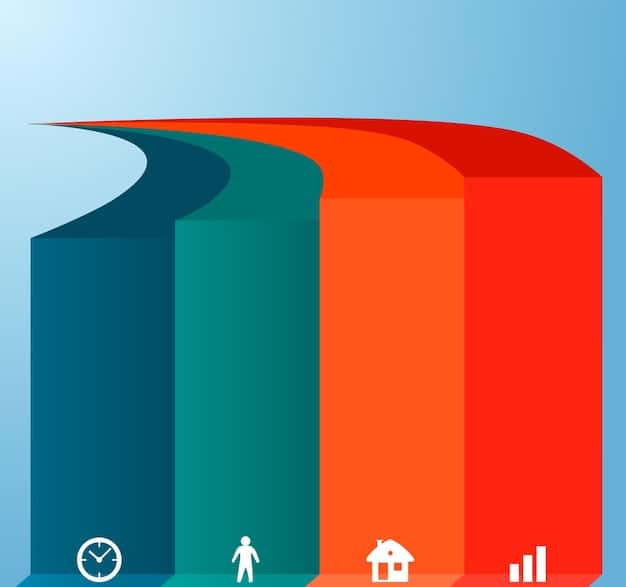Wealth Gap in the US: Policies for Income Equality

Examining the growing wealth gap in the US reveals a stark divide. Policies addressing income inequality, such as progressive taxation, education funding, and minimum wage increases, are crucial to fostering a more equitable society and promoting economic stability.
The examining the growing wealth gap in the United States is an urgent issue demanding immediate attention. This article dives into the widening disparity and explores effective policies to reduce income inequality and foster a more inclusive and equitable society.
Understanding the Wealth Gap in America
The wealth gap represents the unequal distribution of assets among a population. In the US, this gap has been growing for decades, raising concerns about social mobility and economic stability.
Historical Trends of Wealth Disparity
Examining historical data reveals a steady increase in wealth concentration at the top. Factors like globalization, technological advancements, and changes in tax policies have contributed to this trend.
Wealth inequality has followed an alarming trend in the United States over the past few decades. Various economic factors have contributed to this, from policy changes and globalization to technology booms and increasing automation.
- Globalization and Outsourcing: Shifted manufacturing jobs overseas, impacting wages.
- Technological Advancements: Increased demand for high-skilled workers, widening the education gap.
- Tax Policy Changes: Reduced taxes on capital gains and corporate profits, benefiting the wealthy.

Understanding these trends is crucial for recognizing the need for policy interventions and for creating strategies to counter its negative consequences. Without these policies, the American Dream of upward mobility becomes almost impossible for future generations.
The Impact of Income Inequality on Society
Income inequality affects various aspects of society beyond just economics. It impacts health, education, and social cohesion, creating a more divided and less prosperous nation.
Health and Well-being
Studies show a correlation between income inequality and adverse health outcomes. Stress, lack of access to healthcare, and poor living conditions disproportionately affect lower-income individuals.
Educational Opportunities
Children from low-income families often face significant barriers to quality education. Underfunded schools, limited access to resources, and lack of parental support perpetuate the cycle of poverty.
These barriers hinder the ability for social mobility and the pursuit of the American dream for younger generations. In other words, children growing up poor are more likely to remain poor, even with great ambition and potential.
Progressive Taxation as a Solution
Progressive taxation, where higher earners pay a larger percentage of their income in taxes, is often proposed as a tool to reduce income inequality. This revenue can fund social programs and public services.
The term progressive tax refers to a tax that takes a larger percentage of income from high-income earners than it does from low-income earners. These policies aim to help rebalance the economy and create more opportunities for everyone.
- Arguments in Favor: Provides resources for public goods and reduces income disparities.
- Potential Drawbacks: May discourage investment and entrepreneurship.
- Examples: Estate taxes, higher income tax brackets for top earners.
Although this policy is still hotly debated, many point to the potential benefits, such as funding government projects and social safety nets. These can ensure a minimum standard of living for the most vulnerable in society.
Enhancing Education and Skills Training

Investing in education and skills training programs can provide individuals with the tools they need to climb the economic ladder. This includes early childhood education, vocational training, and affordable higher education.
Early Childhood Education
Providing high-quality early childhood education can give children from disadvantaged backgrounds a head start. Research shows lasting benefits in terms of academic achievement and future earnings.
Vocational Training and Apprenticeships
Skills-based training programs can equip individuals with practical skills sought by employers. Apprenticeships combine classroom learning with on-the-job experience, increasing employability.
For those seeking work in trade industries, vocational training may be the best option available. It sets individuals up for self-sufficiency, while simultaneously meeting the demands of the market.
Raising the Minimum Wage
Increasing the minimum wage is a direct way to boost the income of low-wage workers. However, the impact of this policy is a subject of ongoing debate among economists.
Arguments For and Against
Proponents argue that a higher minimum wage reduces poverty and stimulates economic growth. Opponents raise concerns about job losses and increased prices for consumers.
Evidence-Based Analysis
Recent studies offer mixed results on the impact of minimum wage increases. Some show minimal job losses, while others report more significant negative effects, especially in certain industries.
This is likely because the service industry is often staffed by those who earn minimum wage. It remains an area of caution for economists and policy makers who have good reason to implement minimum wage laws.
Strengthening Social Safety Nets
Social safety nets provide a cushion for individuals and families facing economic hardship. These programs include unemployment benefits, food assistance, and affordable housing.
Programs such as Medicaid, CHIP, and food stamps are vital for keeping families afloat during difficult times. They keep families out of poverty by providing some assistance that may not have been previously available.
- Unemployment Benefits: Provide temporary income support to those who lose their jobs.
- Food Assistance Programs: Help low-income families afford groceries.
- Affordable Housing Initiatives: Ensure access to safe and stable housing.
Adequately funding and effectively managing these programs can serve as a crucial method of combating income inequality.
Addressing Discrimination and Promoting Equal Opportunity
Discrimination based on race, gender, and other factors contributes to income inequality. Policy interventions aimed at promoting equal opportunity can help level the playing field.
Affirmative Action Policies
Affirmative action aims to address past and present discrimination by giving preference to underrepresented groups in education and employment.
Enforcing Anti-Discrimination Laws
Strengthening and enforcing anti-discrimination laws can help ensure that all individuals have equal access to opportunities, regardless of their background.
In order to increase economic justice and mobility, these policies are essential. Without ensuring opportunities are made available equally, the American dream will remain unobtainable for many.
| Key Point | Brief Description |
|---|---|
| 💰 Progressive Taxation | Higher earners pay a larger percentage of their income in taxes. |
| 🏫 Education Investment | Enhancing skills through early childhood education and vocational training. |
| ⬆️ Minimum Wage | Increasing wages for low-income workers to reduce poverty. |
| 🛡️ Social Safety Nets | Providing assistance through unemployment benefits and food programs. |
Frequently Asked Questions
▼
The wealth gap refers to the unequal distribution of assets and income among different segments of a population. It highlights the difference between the rich and the poor, and it is a growing issue in the United States.
▼
Income inequality can lead to a host of social and economic problems. It not only hinders economic growth but also affects social mobility, health, and overall well-being, creating a less prosperous nation for all.
▼
Progressive taxation involves higher-income earners paying a larger portion of their income in taxes. The generated revenue is then used to fund social programs, public services and investments in education, aimed at diminishing disparities.
▼
Educational opportunities can enable individuals to climb the economic hierarchy, through vocational training, skill-based programs and apprenticeships. Children from disadvantaged backgrounds can particularly benefit, breaking the cycle of poverty.
▼
Social safety nets like unemployment benefits, food aid, and affordable housing stabilize the most vulnerable in society. These programs provide critical support to those facing economic hardship, ensuring fundamental needs are met.
Conclusion
Addressing examining the growing wealth gap in the US requires a multifaceted approach. Policies targeting taxation, education, wages, social support, and equal opportunity are essential to creating a more equitable and prosperous society for future generations.





